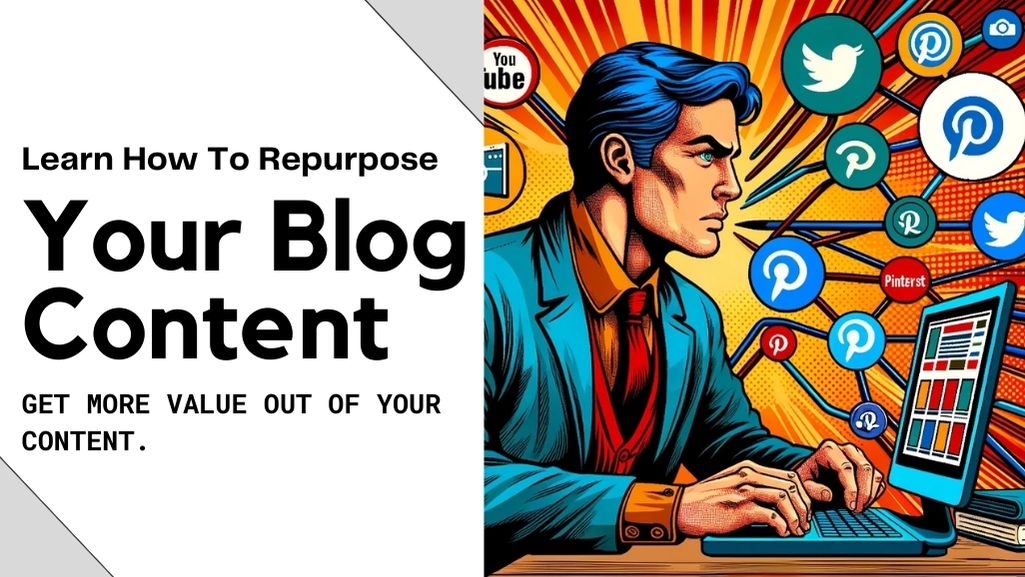You’re sitting on a goldmine. That’s right, your current content – those blog posts, articles, and reports gathering digital dust – are unused treasures just waiting to skyrocket your online presence.
But how, you ask? Simple: content repurposing.
Before you groan at the thought of squeezing more out of your already squeezed schedule, what if you were able to turn one stellar piece into a multipurpose marketing machine?
We’re talking saving bucks, reaching further, and making a lasting impact – all without starting from scratch.
Ready to transform your content from one-time wonders to marketing staples? Well, if so, let’s go through the process.
What is Content Repurposing?
An artist stands in a room, their older paintings surrounding them, each a silent narrative of time, effort, and creativity.
Instead of starting with a blank canvas every time, the artist chooses to take these existing artworks and add new touches, perhaps changing the color scheme, or cropping the images for a new perspective.
This is, in essence, what content repurposing is about – taking the foundation of something valuable and rejuvenating it for continued use and appreciation.
Content repurposing isn’t just about giving old content a fresh coat of paint; it’s a strategic approach that stretches its value and expands its reach.
The content that once lived and thrived in one format can embark on a second life, reaching new audiences in diverse and engaging ways.
Explaining Content Repurposing
Content repurposing is the process of recycling existing content – already researched, written, and designed – into different formats or updating it to be relevant again.
It’s a smart move in the content strategy game. Instead of always digging for new ideas, look at what’s already in the treasure chest and find ways to make it shine for different eyes or in different places.
It demonstrates a certain savviness; a recognition that something good doesn’t need to be a one-and-done deal.
Let’s break it down:
The definition of content repurposing could go like this:
It’s the act of taking a single piece of content and adapting it for delivery over a variety of channels, hence maximizing its potential and reach.
Think of it as a facelift for content; not changing the core, but enhancing its outer appeal to engage more people.
Now, how does this differ from content creation?
When you’re creating content, you’re starting from square one – an empty page, waiting for ideas to take shape.
Repurposing, however, is more about optimization. You’re not pulling concepts from nothing; you’re transforming what you’ve already made into another form that’s just as compelling.
What’s great about repurposing is the array of formats you can use.
A single blog post can be reworked into an infographic that catches the eye, a podcast episode that entertains during a commute, or a series of social media posts that spark conversation across the internet.
The smart use of content repurposing takes a successful piece and gives it multiple lives, in multiple realms, each tailored and optimized for its platform.
This efficient strategy means you’re crafting less from scratch and more from substance.
The core message, research, and insights remain, but how you present it changes each time, like different outfits suited for different events.
When you repurpose content, you’re not just recycling; you’re redoing and enhancing it to reach and connect with a broader audience.
It’s practical, it’s strategic, and it can lead to your content’s bigger success online.
The Benefits of Content Repurposing for Small Businesses
Small businesses often face unique challenges in the digital space.
You’ve got to make every dollar and every minute count, which is why content repurposing is like finding a secret weapon in your marketing arsenal.
It’s not just about saving resources; it’s about amplifying the value of what you already have.
When you repurpose content, you’re essentially multiplying your message without a corresponding increase in time or money spent.
Scalability is the name of the game here.
You want to reach more people, right?
Repurposing content allows you to do exactly that.
You can take a blog post that resonated with your audience and turn it into a video tutorial, a series of tweets, or even a slideshow for LinkedIn.
Each one of these formats opens the door to new platforms and new audiences, expanding your digital footprint without spreading yourself too thin.
Cost and time savings compared to creating new content
Now, let’s get into the specifics of cost and time savings.
Let’s say you’ve got a great blog post. It took hours to research and write, and it’s packed with value.
Instead of starting from zero to create something new, you can take nuggets from that post and give them a new life.
This isn’t just about cutting corners; it’s about being smart with your resources.
By repackaging that blog post into a podcast episode, you save the hours you would have spent on developing a new topic from scratch.
And, because you’re working from a proven foundation, the risk of spending time on content that doesn’t perform well is minimized.
The less time you spend creating, the more time you have for other important aspects of your business.
And when it comes to costs, think about it this way: you’ve already paid in full for the content you’ve created.
Why not get the most out of that investment?
Repurposing content avoids the additional expenses tied to producing entirely new material.
Identifying Evergreen Content for Repurposing
In the digital marketing jungle, evergreen content is the king of the forest.
It’s the content that stays fresh and valuable year after year, just like an evergreen tree keeps its leaves through all seasons.
For a small business, finding and leveraging this type of content can significantly impact your online presence and authority.
The trick is to sift through your existing content and find these evergreen gems.
But how?
Well, it’s not about guessing or gut feelings.
It’s about using the right tools and strategies to make data-based decisions.
Analyzing Your Blog for Evergreen Posts
The process for discovering your evergreen content starts with a look at your blog’s past performance, and Google Analytics is a great platform to do just that.
With this free tool, you can track which pieces have had a lasting impact. Look for blog posts that are not just one-hit wonders but have consistently pulled in visitors over time.
When you’re analyzing, it’s not just about the number of clicks.
You’re looking for signs of deep engagement. How long do people stay on the page? Do they bounce right off, or do they stick around?
These metrics can tell you a lot about the staying power of your content.
Qualitative analysis is the other side of the coin. It’s about understanding the ‘why’ behind the numbers.
Does the content tackle issues that don’t go out of date? Does it answer questions that people will always ask?
If your content is still getting attention, it means it has something timeless to offer.
Updating and Improving Outdated Content
Once you’ve identified the evergreen content, it’s time for some digital gardening.
Give your old posts a refresh to make them relevant for today’s audience. Update the facts, stats, and references to make sure everything is up-to-date.
It’s like giving your content a new lease on life.
But don’t stop there. Aesthetic appeal matters in the online world.
Freshen up stale content with new images, crisp graphics, and current examples. Swap out outdated metaphors for ones that resonate with today’s readers.
It’s about making your content relatable and engaging once more.
And here’s a pro tip: use checklists and worksheets to guide your content audit.
They can help you systematically identify which posts need a refresh and ensure that you don’t miss any details in the update process.
Remember, the goal is to produce evergreen content that aligns with your long-term business objectives.
Each update is an opportunity to reflect your brand’s growth, vision, and direction.
By doing so, you ensure that your content doesn’t just live in the past but is also relevant for your business’s future.
Adapting Content for Different Formats
In the digital world, adapting content across various formats isn’t just smart; it’s essential for reaching more people and getting more attention.
The way you present your message can dramatically change its impact, depending on whether you’re working with a blog post, a video, or a podcast.
Let’s break down how to make sure your core content flows smoothly through these different content types.
Best Practices for Format-Specific Content
When customizing your content for each medium, you should first think about the unique strengths and user experiences of each format.
For blogs, clarity and readability are key.
Write your posts with short paragraphs, subheadings, and bullet points.
This makes your content easy to understand for readers who typically scan to pick up the main points.
Videos, however, thrive on visual storytelling.
Your blog’s detailed explanations turn into concise messages together with visuals that can show processes or emphasize points more effectively than text.
And don’t forget podcasts. They offer a personal touch and allow for in-depth discussions.
Summarize your blog post into key points, and turn that into a story that’s conversational and easy to listen to.
The trick is keeping the core message the same. It shouldn’t lose its power, no matter where it goes.
This isn’t about making a carbon copy for each platform but translating your message so it feels right for that specific format.
Transforming Blogs to Visual Content
Visual content, like infographics, can turn a dense blog post into an easy-to-understand and shareable piece.
To turn your blog into an infographic, start by identifying the key points and data that stand out.
What’s the story?
What are the main takeaways?
Use those as your foundation in a visual format that tells the story at a glance.
For those who aren’t design experts, no worries.
Tools like Canva or Piktochart offer easy-to-use infographic templates and drag-and-drop features that make design possible for everyone.
Slide decks are another great way to reuse blog content, especially for educational or formal presentations.
With slide decks, you can summarize your blog into bullet points and key takeaways, using text, images, and graphics to walk your audience through your story one visual step at a time.
Platforms like Google Slides or PowerPoint offer customizable templates that let you match the design to your brand’s style without needing to be a pro designer.
Whether you’re turning blog posts into infographics or slide decks, the goal stays the same: present your message clearly and powerfully in a format that connects with your audience and feels natural for the platform you’ve chosen.
Leveraging Social Media Platforms
Social media platforms are like different stages where your content can perform.
Each stage has its own set of rules, audience, and atmosphere.
To make the most of these stages, you need to bring the essence of your content into the spotlight in a way that fits each one’s unique scene.
Its about taking that well-crafted blog post and breaking it down into bite-sized pieces that social media users can easily digest and enjoy.
Optimizing Content for Social Sharing
To optimize your content for social sharing, think of your message as a series of snackable moments.
For example, you can distill a blog post into a compelling question for Twitter, a striking image for Instagram, or an insightful comment for LinkedIn.
Each piece should be tailored not only to fit the character limits or visual preferences of the platform but to engage the users who hang out there.
Maximize shareability with posts that get straight to the point.
Use powerful and relevant hashtags to join wider conversations, and don’t shy away from tagging influencers who might amplify your reach.
Write with the platforms culture in mind – be it the professionalism of LinkedIn, the casual banter of Twitter, or the visual storytelling of Instagram.
Maintaining Brand Consistency Across Channels
While customizing your content for each platform, make sure your brands heart and soul are in every piece.
That means having a consistent voice and messaging across all channels.
Your audience should feel like they’re hearing from the same friend, whether they’re scrolling through Twitter, LinkedIn, or Facebook.
Create guidelines that lay out your brands personality traits, talking points, and visual style.
Make them clear enough so anyone handling your content knows how to keep the brand’s voice unified.
Its like having a signature style that people recognize, no matter where they see you.
Now, managing all these social media channels might seem daunting, but that’s where social media management systems step in to save the day.
Tools like Hootsuite or Buffer help you schedule posts, track engagement, and analyze how your content performs across different platforms.
These systems are your backstage crew, making sure that the show goes on smoothly and that your content gets its moment in the limelight.
When you leverage social media platforms effectively, you don’t just broadcast your message – you create a dialogue with your audience that can lead to lasting relationships and brand loyalty.
Amplifying Reach Through Syndication and Distribution
Content syndication is like a multi-city tour for your best blog content.
Instead of only showing it on your blog, you’re putting that content center stage on different sites – industry websites and content aggregators.
This move can take your brand’s message and make it louder across the digital landscape, reaching potential new fans who hang out on those third-party sites.
Republishing on Industry Websites and Aggregators
Industry websites and content aggregators are like popular spots where people go to find out what’s happening.
These platforms are customized for specific interests, from tech to health to roofing, and they can introduce your content to an engaged audience.
When you republish your content here, you’re putting it right into the hands of an interested crowd.
But it’s not just about dropping your content off and leaving. You need to adapt it to fit the new context while still keeping ownership.
Make sure any contract clearly states that you keep ownership of your content, and tweak your posts to match the style and tone of the website or aggregator you’re partnering with.
Executing an Effective Cross-Channel Distribution Strategy
A cross-channel distribution strategy is about being everywhere your audience is but in a strategic way.
You’ve got your original blog, but also share adapted versions of that content on social media, email newsletters, industry blogs, and more.
Each channel offers unique eyes and ears for your content.
The key is to coordinate your approach so you’re strategically placing content where it will have the most impact.
By tracking where your content performs best, you can focus efforts and refine your strategy for maximum ROI.
Businesses that use this multi-channel approach often see a big return on investment.
They’re not just reaching more people; they’re reaching the right people, where their content can thrive.

Practical Tools and Examples
When you’re ready to take your content to new heights, its not just about the ‘why’ and ‘how’ its also about the ‘with what.’
There are tools out there designed to help you transform your existing content into different formats, and businesses just like yours are using them to grow and succeed.
Real-World Examples of Successful Content Repurposing
Let’s look at a few small businesses that hit it out of the park with content repurposing.
A local bakery, for instance, took their most popular blog post about sourdough bread and spun it into a series of quick-tip videos.
These videos were shared on Instagram and YouTube, showing the bread-making process.
The result?
An explosion in views and shares, which brought the bakery new customers eager to taste the bread they saw being made on their screens.
Another example is a home-improvement business that condensed their comprehensive guide on choosing the right type of paint into an eye-catching infographic.
This visual content was shared on Pinterest and picked up by DIY blogs, which led to a big increase in website traffic and a boost in paint sales.
These businesses didn’t just reuse old content.
They reinvented it, reaping the rewards of increased visibility and new customer interest.
Recommended Tools and Resources
To get started on repurposing your own content, here’s a list of key tools and resources:
- Canva: With free and paid subscriptions (starting at around $12.95 per month), Canva lets you create professional-looking graphics and layouts for infographics, social media posts, and more.
- Anchor: If you want to try your hand at podcasting, Anchor is a free platform that offers easy recording, editing, and distribution capabilities.
- Lumen5: For converting your blog content into engaging videos, Lumen5 uses artificial intelligence. It offers various pricing tiers starting from free to premium services.
- BuzzSumo: To get insights into what content performs best for repurposing, BuzzSumo offers understandings into content sharing. Plans start with a limited free version and scale up for more in-depth analytics.
These tools offer tutorials and support to help you get the most out of their features.
Make sure to check out the actionable tips and tutorials that come with these platforms.
They will guide you through the process of turning your existing blog posts into new content goldmines.
Remember, these tools aren’t just there to make things look pretty; they’re there to maximize the value of your content and help your brand grow.
Closing Out
You’re ready to take those old digital gems and make them shine all over the web. Remember, repurposing is not an option – it’s a must.
You’ve got the know-how, the tools, and the plan. Now it’s time to take action.
Start with that evergreen content that keeps on giving, and freshen it up for today’s readers. Break it down, jazz it up, and spread it out into the formats your audience loves.
Use Canva, Anchor, Lumen5, and BuzzSumo to make the magic happen. Your content’s second life is waiting for you, and it’s brighter than ever.
Get out there and put the spotlight on your brand. Go on, give your content new wings – and watch your online presence take off.



